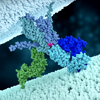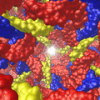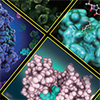 |
What is a Protein?Proteins play countless roles throughout the biological world, from catalyzing chemical reactions to building the structures of all living things. Despite this wide range of functions all proteins are made out of the same twenty amino acids, but combined in different ways. The way these twenty amino acids are arranged dictates the folding of the protein into its primary, secondary, tertiary, and quaternary structure. Since protein function is based on the ability to recognize and bind to specific molecules, having the correct shape is critical for proteins to do their jobs correctly. Learn more about the relationship between protein structure and function in this video. |
 |
How Enzymes Work |
 |
How Neurons CommunicateThe billions of neurons in our nervous system are constantly communicating. The signals they send to each other are responsible for our thoughts, sensations, and actions. Learn how ions, ion channels, receptors, and neurotransmitters work together to enable the neuronal signaling process. |
 |
Vitamin A and VisionLearn how vitamin A activates the molecular pathways that are essential for vision. |
 |
Caffeine and Adenosine: Antagonist and AgonistThis short video uses the example of adenosine and caffeine to introduce two key concepts in pharmacology: the agonist and the antagonist. Both, adenosine, and caffeine molecules bind to adenosine receptors on the neurons. Caffeine, the antagonist, blocks the receptor, while adenosine, the agonist, produces the biological response upon binding. |
 |
Opioids and Pain SignalingPain is one of the most trying experiences of life. On the cellular level it is communicated via special neuronal pathways. On the molecular level, however, pain is communicated like any other sensation, via a set of electrical and chemical signals facilitated by complex molecular machinery. These signals can be modulated by opioids, causing us to feel less pain, or no pain at all. Learn how opioids activate the G-proteins which in turn interact with other proteins to edit the pain signal. |
 |
Neuronal Signaling and Sodium-Potassium PumpExplore the concepts of resting and action potentials and the role of sodium-potassium pump in regulating them. |
PhotosynthesisPlants use photosynthesis to capture energy from sunlight |
|
Calcium PumpThe calcium pump moves ions across cell membranes allowing the synchronized contraction of muscle cells. |
|
AconitaseAconitase converts citrate into isocitrate as part of the citric acid cycle. |
|
 |
Celebrating 50 Years of the Protein Data Bank ArchiveIn 1971, the structural biology community established the single worldwide archive for macromolecular structure data–the Protein Data Bank (PDB). From its inception, the PDB has embraced a culture of open access, leading to its widespread use by the research community. PDB data are used by hundreds of data resources and millions of users exploring fundamental biology, energy, and biomedicine. This video looks at the history and the milestones that shaped the PDB into the leading resource for research and education it is today. |
 |
Methods for Determining Atomic StructuresThese videos below give a brief overview of the three main methods for determining the atomic structures: X-ray crystallography, NMR spectroscopy, and electron microscopy. |
 |
Immunology and CancerThis three-part series explores the human immune response to cancer focusing on cellular and molecular details of the process. |
Target Zero: Preventing HIV Transmission DocumentaryTarget Zero shows the challenge and emotional complexity of the fight to control HIV infection. |
|
 |
Fighting Coronavirus with SoapAlways use soap when you wash your hands! Soap molecules break up the outer envelope of viruses such as coronavirus, stopping infection. |
Penicillin and Antibiotic ResistanceSince its discovery in 1928, penicillin and penicillin-related antibiotics helped save countless lives from bacterial infections. However, in the face of overuse and misuse of antibiotics, bacteria evolved resistance mechanisms that allow them to proliferate even in the presence of the newest antibiotics. |
|
 |
Ebola Virus ProteinsTour the molecular anatomy of the Ebola virus with the RCSB PDB. Understanding of the shape and structure of the proteins that make up Ebola is a key component in the fight against the virus. Learn more at Molecule of the Month. |
 |
A Molecular View of HIV TherapyAfter HIV enters a T-cell, three enzymes play essential roles in the life cycle of the virus. Reverse transcriptase copies the viral RNA genome and makes a DNA copy. Integrase inserts this viral DNA into the cell’s DNA. In the last steps of the viral life cycle, HIV protease cuts HIV proteins into their functional parts. Current antiretroviral drugs target these three enzymes, hindering the virus reproduction. However, enzymes can mutate and become drug resistant, making it vital to use a combination of different drugs that target multiple enzymes. This animation was created using many PDB entries for Reverse Transcriptase (3hvt, 3dlk, 3v6d, 3v4i, 3klg, 3v81), Integrase (3os1, 3os0, 3oya), Protease (3pj6, 1kj4, 1hxb, 2az9, 2azc), HIV Polyprotein (1l6n), Capsid Protein (2m8l), and Matrix Protein (1tam). |
 |
Learn about HIV from the RCSB Protein Data BankUse the RCSB PDB Resources to Learn about HIV |
 |
RCSB PDB: An Empowering Resource for Understanding HIV/AIDS at a Molecular LevelThis seminar was presented by Stephen K. Burley, MD, DPhil, and Shuchismita Dutta, PhD on December 5th 2014 as part of the World AIDS Day Symposium at the Rutgers Center for Integrative Proteomics Research in Piscataway, NJ. |
 |
Staphylococcus aureus and Antibiotic ResistanceHow penicillin and other beta-lactam antibiotics work and what mechanisms the resistant bacteria use it to evade them. |
ATP synthaseATP synthase |
|
AconitaseAconitase converts citrate into isocitrate as part of the citric acid cycle. |
|
 |
Artificial lattice of a designed DNA crystalDesigned DNA crystal: Small pieces of DNA have been engineered to form a nanoscale lattice. |
 |
Coronavirus Main ProteaseSARS-CoV-2 main protease protein with inhibitor N3 |
 |
Oxygen Binding in HemoglobinHemoglobin uses a change in shape to increase the efficiency of oxygen transport. |
 |
Photoactive Yellow Protein and XFEL/SFXStructures of photoactive yellow protein were determined by serial femtosecond crystallography after illumination, capturing the isomerization of the chromophore after it absorbs light. Structures included in this movie include: 5hd3 (ground state), 5hdc (100-400 femtoseconds after illumination), 5hdd (800-1200 femtoseconds), 5hds (3 picoseconds), 4b9o (100 picoseconds), 5hd5 (200 nanoseconds) and 1ts0 (1 millisecond). For more, see the Molecule of the Month on Photoactive Yellow Protein and Guide to Understanding PDB Data: Methods for Determining Atomic Structures |
 |
Ribosomal SubunitsAtomic structures of the ribosomal subunits reveal a central role for RNA in protein synthesis. Ribosomes are complex molecular machines that build proteins. |
 |
Vacuolar ATPaseTwo linked molecular motors are used to pump protons across membranes. |
 |
X-ray Crystallography |
 |
2023 Molecular Mechanisms of Targeted Cancer Therapies |
 |
2022 Molecular Mechanisms of Cancer |
 |
2021 Molecular Mechanisms of Drugs for Mental Disorders |
2020 Molecular Mechanisms of Opioid Action |
|
 |
2019 Mechanisms of Bacterial Resistance to Aminoglycoside Antibiotics |
 |
2018 Bacterial Resistance to Beta-lactam AntibioticsFor the fifth year, RCSB PDB invited high school students to tell molecular stories in video. This year's challenge focused on the molecular mechanisms behind bacterial resistance to Beta-lactam antibiotics |
 |
2017 DiabetesFor the fourth year, RCSB PDB invited high school students to tell molecular stories in video. This year's challenge focused on the molecular view of the diabetes treatment and management. |
 |
2016 DiabetesWinning videos in the 2016 Video Challange for High School Students "Structural Biology & Diabetes" |
 |
2015 HIVWinning videos in the 2015 Video Challenge for High School Students "Detecting and Combatting HIV in 3D" |
 |
2014 HIVWinning videos in the 2014 Video Challenge for High School Students "Structural Biology of HIV" |
 |
Visualizing PDB Structures with UCSF ChimeraUse UCSF Chimera to create images and animations featuring PDB structures |
Exploring PDB structures in 3D with MolStar |
|
 |
Molecular Animation Q&A |
About PDB-101
Researchers around the globe make 3D structures freely available from the Protein Data Bank (PDB) archive. PDB-101 training materials help graduate students, postdoctoral scholars, and researchers use PDB data and RCSB PDB tools. Outreach content demonstrate how PDB data impact fundamental biology, biomedicine, bioengineering/biotechnology, and energy sciences in 3D by a multidisciplinary user community. Education Materials provide lessons and activities for teaching and learning.
PDB-101 is developed by the RCSB PDB.
RCSB PDB Core Operations are funded by the U.S. National Science Foundation (DBI-2321666), the US Department of Energy (DE-SC0019749), and the National Cancer Institute, National Institute of Allergy and Infectious Diseases, and National Institute of General Medical Sciences of the National Institutes of Health under grant R01GM157729.